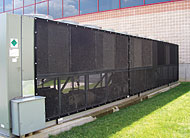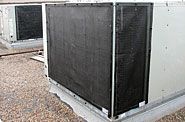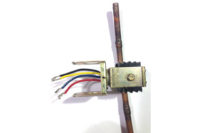FIRST LEVEL CHILLER FAILURE
It is commonly known throughout the industry that even the slightest coil fouling leads to what can be described as the first level of failure. This is distinguished by a higher operating compressor head pressure caused by elevated refrigerant pressure resulting from restricted airflow and poor heat exchange, reduced cooling capacity caused by poor airflow through the coils, increased kilowatt (kW) draw coupled with a reduction in cooling tonnage capacity, the unit runs longer and works harder to achieve set temperature points, and the compressor keeps cycling off and on under high head pressure because it is being stressed under dirty coil conditions and the system is overheating.
Unless you monitor the chiller kW draw with an energy management system or with a separate metering device, you will most likely learn about the problem when it's hot and you are unable to maintain chilled water and/or environmental temperatures, when you see your energy consumption skyrocketing, or when your compressor fails.
In process cooling applications where a chiller supports production, fouled coils have other ramifications such as the overheating of production equipment like process computer control equipment and robotic welding systems, which can cause product quality problems and possible equipment failure, bringing production to a halt.

SECOND LEVEL CHILLER FAILURE
Then there is what can be called a second level chiller failure.Consider this real-life situation: A 20-ton chiller used to cool a computer control room of a major automotive parts manufacturer. The chiller became fouled and is in need of cleaning. But because the maintenance department was short handed, they didn't have the time to perform the maintenance when it was needed. So maintenance was put-off for an unspecified period of time. Eventually, the debris load completely fouled the chiller coils, resulting in a second level failure having a catastrophic impact on the business.
The characteristic and cost implications of second level chiller failure includes compressor failure and productivity loss.
The computer room experienced a computer failure due to overheating, and the company was forced to replace the failed computer equipment while running production at reduced capacity until the chiller was back on-line.
Procurement of the new compressor took two days and resulted in two days of downtime and lost productivity on three computer controlled production lines resulting in a $500,000 per day production loss (Note: While the situation described is a real-life scenario, lost production cost will vary depending upon product and production process).
Management sent home production workers with full pay and benefits until the chiller was back up and running and the company missed shipments resulting in customer dissatisfaction.
When the repairs were made the costs included compressor replacement, $7,500; compressor installation, $4,000; production equipment startup cost, $10,000 (includes the cost of raw material waste resulting from make-ready and production line startup); and coil cleaning, $1,500.
If the coil cleaning and maintenance had been performed before the first level of failure, it could have only cost $1,500. However because it was deferred and operation continued until the second level of failure, the costs associated with the second failure level wound up costing over $1 million.
WHERE'S THE BACKUP
Now you might be wondering why there wasn't a backup unit in place for this critical application. Well, the fact is the backup consisted of spot coolers that were moved around the computer room to vital locations, but the spot coolers were only used to augment the cooling when needed. They weren't designed for the full load of the computer room.So the question still stands: Where was the backup chiller? The answer is: In this situation, there wasn't one. This particular operation had converted the mechanically controlled production equipment to new computer control systems, and as a result, the computer room supported by the chiller took on additional cooling loads. Even though the computer room had both computer and electrical backup systems, the cooling system had not yet been upgraded and was the Achilles' heel of the production facility.
Preventive maintenance should have been of vital importance in this facility.

WHY DEFER MAINTENANCE?
There are many reasons cited by facilities and maintenance directors for deferring maintenance. However, it's important to keep in mind that regardless of the reasons, when equipment is in need of maintenance, deferring it for any reason will not change the fact that the maintenance is needed. Do any of these reasons sound familiar?
Why? Because companies have been forced to reduce staff and streamline operations to conform to the economic realities of the business, or cannot find qualified personnel. This places additional demand on maintenance engineers because they now have to do more with less. If chillers and condensing units support mission critical operations and facilities, then the maintenance of those systems should be near the top of the to do list even when the maintenance department is busy or short handed.
To help improve maintenance efficiency and reduce the time required for performing the maintenance task, the maintenance should be outsourced to a reliable service company or technologies such as air intake coil filters should be evaluated. In short, investment in technologies that can optimize operational efficiency and reduce the maintenance effort should be considered in lean maintenance staffing situations.
Although cleaning coils is, in fact, a dirty job, that is not a sound reason for deferring maintenance. When cleaning coils, proper safety equipment including eye and respiratory protection, rubber gloves, and protective outerwear should be worn to protect against coil cleaning chemicals and possible mold or bacteria problems that can pose a health hazard.
As an alternative, you can use air intake filtration systems that isolate the debris on the outside of the coils where it is visible and easier to clean using an ordinary broom, brush or shop vacuum. This can reduce the hassle factor associated with this important maintenance task.
The list of reasons for deferring maintenance can go on and on but one thing is clear: Deferring maintenance on HVAC equipment can be risky; can increase the odds that a system failure will occur; and when it does, it will usually cost more than the cost of the maintenance that could have prevented the failure in the first place.
Randy Simons is the vice president of Air Solution Co., a manufacturer of air intake filtration systems for chiller and condensing coils, cooling towers, rooftop units, and other high volume/high velocity air intake systems. For information, go to www.airsolutioncompany.com.
Publication date: 06/05/2006


Report Abusive Comment